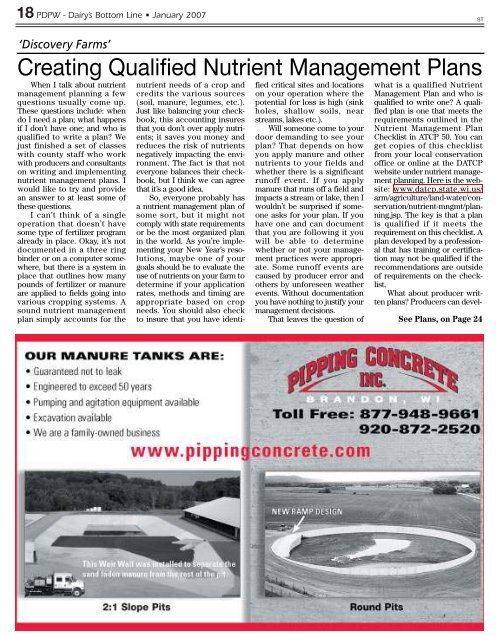Dairy's Bottom Line - Professional Dairy Producers of Wisconsin
Dairy's Bottom Line - Professional Dairy Producers of Wisconsin
Dairy's Bottom Line - Professional Dairy Producers of Wisconsin
You also want an ePaper? Increase the reach of your titles
YUMPU automatically turns print PDFs into web optimized ePapers that Google loves.
18 PDPW - <strong>Dairy</strong>’s <strong>Bottom</strong> <strong>Line</strong> • January 2007ST‘Discovery Farms’Creating Qualified Nutrient Management PlansWhen I talk about nutrientmanagement planning a fewquestions usually come up.These questions include: whendo I need a plan; what happensif I don’t have one; and who isqualified to write a plan? Wejust finished a set <strong>of</strong> classeswith county staff who workwith producers and consultantson writing and implementingnutrient management plans. Iwould like to try and providean answer to at least some <strong>of</strong>these questions.I can’t think <strong>of</strong> a singleoperation that doesn’t havesome type <strong>of</strong> fertilizer programalready in place. Okay, it’s notdocumented in a three ringbinder or on a computer somewhere,but there is a system inplace that outlines how manypounds <strong>of</strong> fertilizer or manureare applied to fields going intovarious cropping systems. Asound nutrient managementplan simply accounts for thenutrient needs <strong>of</strong> a crop andcredits the various sources(soil, manure, legumes, etc.).Just like balancing your checkbook,this accounting insuresthat you don’t over apply nutrients;it saves you money andreduces the risk <strong>of</strong> nutrientsnegatively impacting the environment.The fact is that noteveryone balances their checkbook,but I think we can agreethat it’s a good idea.So, everyone probably hasa nutrient management plan <strong>of</strong>some sort, but it might notcomply with state requirementsor be the most organized planin the world. As you’re implementingyour New Year’s resolutions,maybe one <strong>of</strong> yourgoals should be to evaluate theuse <strong>of</strong> nutrients on your farm todetermine if your applicationrates, methods and timing areappropriate based on cropneeds. You should also checkto insure that you have identifiedcritical sites and locationson your operation where thepotential for loss is high (sinkholes, shallow soils, nearstreams, lakes etc.).Will someone come to yourdoor demanding to see yourplan? That depends on howyou apply manure and othernutrients to your fields andwhether there is a significantrun<strong>of</strong>f event. If you applymanure that runs <strong>of</strong>f a field andimpacts a stream or lake, then Iwouldn’t be surprised if someoneasks for your plan. If youhave one and can documentthat you are following it youwill be able to determinewhether or not your managementpractices were appropriate.Some run<strong>of</strong>f events arecaused by producer error andothers by unforeseen weatherevents. Without documentationyou have nothing to justify yourmanagement decisions.That leaves the question <strong>of</strong>what is a qualified NutrientManagement Plan and who isqualified to write one? A qualifiedplan is one that meets therequirements outlined in theNutrient Management PlanChecklist in ATCP 50. You canget copies <strong>of</strong> this checklistfrom your local conservation<strong>of</strong>fice or online at the DATCPwebsite under nutrient managementplanning. Here is the website:www.datcp.state.wi.us/arm/agriculture/land-water/conservation/nutrient-mngmt/planning.jsp.The key is that a planis qualified if it meets therequirement on this checklist. Aplan developed by a pr<strong>of</strong>essionalthat has training or certificationmay not be qualified if therecommendations are outside<strong>of</strong> requirements on the checklist.What about producer writtenplans? <strong>Producers</strong> can devel-See Plans, on Page 24



